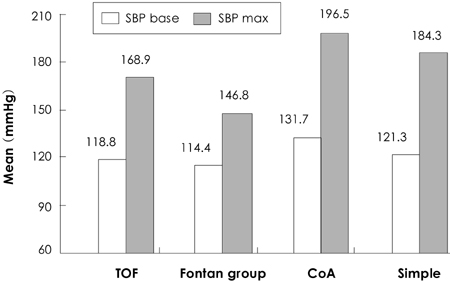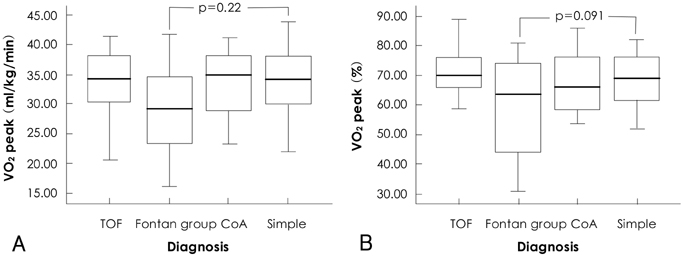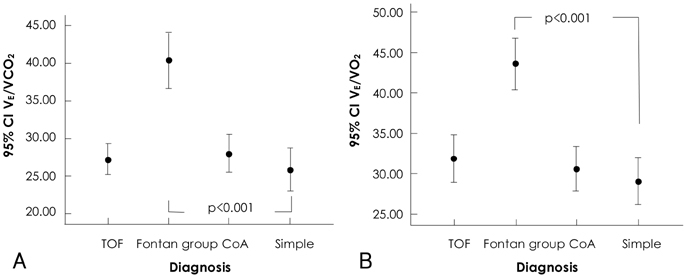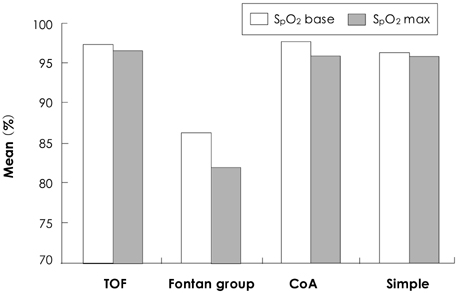Korean Circ J.
2007 Oct;37(10):489-496. 10.4070/kcj.2007.37.10.489.
Usefulness of the Cardiopulmonary Exercise Test in Congenital Heart Disease
- Affiliations
-
- 1Department of Pediatrics, Seoul National University, Children's Hospital, Seoul, Korea. chungnoh@plaza.snu.ac.kr
- 2Department of Pediatric Cardiac Surgery, Seoul National University, Children's Hospital, Seoul, Korea.
- KMID: 2227050
- DOI: http://doi.org/10.4070/kcj.2007.37.10.489
Abstract
-
BACKGROUND AND OBJECTIVES: This study aimed to evaluate the usefulness of cardiopulmonary exercise test (CPET) in children with various congenital heart diseases (CHDs).
SUBJECTS AND METHODS
Forty-eight children and adolescents (18 girls and 30 boys; mean+/-SD age, 12.6+/-0.5 years) with CHD who had undergone corrective surgery performed CPET using a programmable treadmill. The participants were divided into 4 groups based on the surgery performed: Fontan operation (12 patients), total correction for tetralogy of Fallot (13 patients), repair for coarctation of aorta (11 patients), and corrective surgery for simple CHDs (12 patients). Patients with simple CHDs who had undergone an early surgery were selected as controls.
RESULTS
Progressive exercise time was the longest in the simple CHD group than in the other groups (10.6+/-2 versus 8.2-8.7 min, p=0.122). Absolute and predicted values of mean peak oxygen consumption were the lowest in the Fontan operation group (p=0.220 and 0.091, respectively). The coarctation of aorta group exhibited a prominent blood pressure response, that is, an elevation in the systolic blood pressure relative to that in the other groups at rest (131.7+/-18.8 versus 114.4-121.3 mmHg) and at peak exercise (196.5+/-41.5 versus 146.8-184.3 mmHg).
CONCLUSION
CPET can be a useful tool to clarify the exercise capacity and reflect the hemodynamic status of patients who have undergone surgery for various CHDs and other heart diseases.
MeSH Terms
Figure
Cited by 1 articles
-
Comparison of Predicted Exercise Capacity Equations in Adult Korean Subjects
Daehyun Jeong, Yeon-Mok Oh, Sei Won Lee, Sang-Do Lee, Jae Seung Lee
J Korean Med Sci. 2022;37(14):e113. doi: 10.3346/jkms.2022.37.e113.
Reference
-
1. Galioto FM. Garson A, Bricker JT, Fisher DJ, editors. Physical activity for children with cardiac disease. The Science and Practice of Pediatric Cardiology. 1998. Vol. 1. Baltimore: Williams and Wilkins;2585–2592.2. Bar-Or O. Skinner JS, editor. Importance of differences between children and adults for exercise testing and exercise prescription. Exercise Testing and Exercise Prescription for Special Cases. 1993. Philadelphia: Lea and Febiger;57–74.3. Oren A, Sue DY, Hansen JE, Torrance DJ, Wasserman K. The role of exercise testing in impairment evaluation. Am Rev Respir Dis. 1987. 135:230–235.4. Norozi K, Gravenhorst V, Hobbiebrunken E, Wessel A. Normality of cardiopulmonary capacity in children operated on to correct congenital heart defects. Arch Pediatr Adolesc Med. 2005. 159:1063–1068.5. Ohuchi H, Nakajima T, Kawade M, Matsuda M, Kamiya T. Measurement and validity of the ventilatory threshold in patients with congenital heart disease. Pediatr Cardiol. 1996. 17:7–14.6. Wasserman K. Wasserman K, Hansen JE, Sue DY, Stringer WW, Whipp BJ, editors. Measurements during integrating cardiopulmonary exercise testing. Principles of Exercise Testing and Interpretation: Including Pathophysiology and Clinical Applications. 2005. 4th ed. Philadelphia: Lippincott Williams & Wilkins;76–106.7. American Thoracic Society/American College of Chest Physicians. American Thoracic Society/American College of Chest Physicians statement on cardiopulmonary exercise testing. Am J Respir Crit Care Med. 2003. 167:211–277.8. Wasserman K, McIlroy MB. Detecting the threshold of anaerobic metabolism n cardiac patients during exercise. Am J Cardiol. 1964. 14:844–852.9. Weber KT, Kinasewitz GT, Janicki JS, Fishman AP. Oxygen utilization and ventilation during exercise in patients with chronic cardiac failure. Circulation. 1982. 65:1213–1223.10. Ribeiro JP, Hartley LH, Colucci WS. Effects of acute and chronic pharmacologic interventions on exercise performance in patients with congestive heart failure. Heart Fail. 1985. 1:102–111.11. Mancini DM, Eisen H, Kussmaul W, Mull R, Edmunds LH, Wilson JR. Value of peak exercise oxygen consumption for optimal timing of cardiac transplantation in ambulatory patients with heart failure. Circulation. 1991. 83:778–786.12. Hill AV, Lupton CNH. Muscular exercise, lactic acid and the supply and utilization of oxygen. Q J Med. 1923. 16:135–171.13. Armstrong N, Welsman J, Winsley R. Is peak VO2 a maximal index of children's aerobic fitness? Int J Sports Med. 1996. 17:356–359.14. Ohuchi H. Cardiopulmonary response to exercise in patients with the Fontan circulation. Cardiol Young. 2005. 15:Suppl 3. 39–44.15. Diller GP, Dimopoulos K, Okonko D, et al. Exercise intolerance in adult congenital heart disease: comparative severity, correlates, and prognostic implication. Circulation. 2005. 112:828–835.16. Clark AL. Exercise and heart failure: assessment and treatment. Heart. 2006. 92:699–703.17. Driscoll DJ. Allen HD, Gutgesell HP, Clark EB, Driscoll DJ, editors. Exercise testing. Moss and Adams' Heart Disease in Infants, Children, and Adolescents Including the Fetus and Young Adult. 2001. Vol. 1:6th ed. Phildelphia: Lippincott Williams & Wilkins;264–275.18. Strömvall Larsson E, Eriksson BO. Haemodynamic adaptation during exercise in Fontan patients at a long-term follow-up. Scand Cardiovasc J. 2003. 37:107–112.19. de Divitiis M, Pilla C, Kattenhorn M, et al. Vascular dysfunction after repair of coarctation of the aorta: impact of early surgery. Circulation. 2001. 104:Suppl I. I165–I170.20. Ohuchi H, Yasuda K, Hasegawa S, et al. Influence of ventricular morphology on aerobic exercise capacity in patients after the Fontan operation. J Am Coll Cardiol. 2001. 37:1967–1974.21. Ohuchi H, Ohashi H, Takasugi H, Yamada O, Yagihara AT, Echigo S. Restrictive ventilatory impairment and arterial oxygenation characterize rest and exercise ventilation in patients after the Fontan operation. Pediatr Cardiol. 2004. 25:513–521.22. Fredriksen PM, Kahrs N, Blaasvaer S, et al. Effect of physical training in children and adolescents with congenital heart disease. Cardiol Young. 2000. 10:107–114.23. Moalla W, Maingourd Y, Gauthier R, Cahalin LP, Tabka Z, Ahmaidi S. Effect of exercise training on respiratory muscle oxygenation in children with congenital heart disease. Eur J Cardiovasc Prev Rehabil. 2006. 13:604–611.24. Thaulow E, Fredriksen PM. Exercise and training in adults with congenital heart disease. Int J Cardiol. 2004. 97:Suppl. 35–38.
- Full Text Links
- Actions
-
Cited
- CITED
-
- Close
- Share
- Similar articles
-
- Cardiopulmonary Exercise Testing and Interpretation of the Major Related Variables in Patients with Congenital Heart Disease
- Optimal pH during Cardiopulmonary Bypass in Congenital Heart Disease
- Evaluation of Cardiopulmonary Function in the Patients with Ankylosing Spondylitis Using Exercise Stress Test
- The Effect of a Self Exercise Program in Cardiac Rehabilitation for Patients with Coronary Artery Disease
- Breathing Reserve Index at Anaerobic Threshold of Cardiopulmonary Exercise Test in Chronic Obstructive Pulmonary Disease





